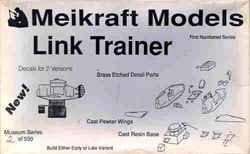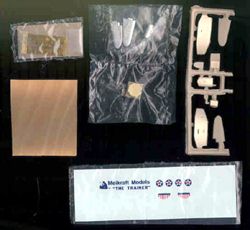 Meikraft Models 1/72 scale Link Trainer Meikraft Models 1/72 scale Link Trainer
Perhaps the most aptly named device to see service before, during, and immediately after the Second World War, the Link Trainer took the student pilot from classroom theory to operating an aircraft without ever leaving the ground. The Link was simply a single seat cockpit with a blind flying hood that was attached to a series of electrically driven pumps and gyroscopes, all carefully balanced to allow the device to simulate dives, climbs, turns, and even spins and stalls in a very realistic manner. The entire device was connected to the instructor's table via radio and every move that the student made was recorded on a chart via a device know as a "Crab". The instructor was equipped with a matching set of instruments along with radio communication and could follow every move made by the student. With the hood opened the Link was used to familiarize the student with aircraft instruments. With the hood down instrument and "blind" flying took place. Some Links were used for navigational training while others were used to teach basic gunnery "lead and lag" with model targets, a dummy gun, and the hood left off.  Early variants of the Link Trainer featured a blunt nose with small vent cover, V-shaped exterior bracing, and twin wing braces. Later variants had the larger nose, squared U-shaped exterior bracing, and only single wing braces. Dummy wings and tail surfaces were sometimes left off. Early variants of the Link Trainer featured a blunt nose with small vent cover, V-shaped exterior bracing, and twin wing braces. Later variants had the larger nose, squared U-shaped exterior bracing, and only single wing braces. Dummy wings and tail surfaces were sometimes left off.
Colors were usually gloss blue fuselage and yellow wings and tail, with black details. This unusual kit has got to be in the running as one of the smallest "aircraft" models ever to be made in 1/72 scale! It consists of eight pieces molded in tan plastic, three white metal pieces that strangely duplicate the plastic "canopy" and wings, a resin base, and a tiny sheet of photo-etched parts for the tail surfaces and cockpit details. Because of its simplicity this is probably one of the easiest Meikraft kits to build and I wouldn't expect any problems other than having to open up the cockpit area. What little surface detail present is very lightly recessed or raised, as appropriate, and could easily disappear under a couple coats of paint. The kit makes the late version out of the box so converting it to any early version would be easy - just chop off the nose and make the V-shaped bracing (either style needs to be done from scratch in any case). Despite the claim on the box, only one set of markings is provided but I doubt that would be an insurmountable problem for anyone with even the barest of decal caches. Apparently only 550 of these kits were produced, and mine is marked as number two. A cute little model and highly recommended for fans of WWII US aircraft if an example can be found at a reasonable price. See you all again next month. Till then, model on and "Build what YOU like, the way YOU want to."
Be sure to visit Al's Place while you're surfing the 'Net! |


 




|